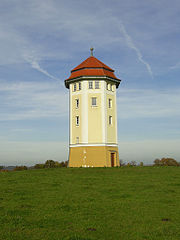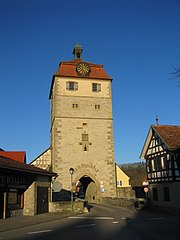The Swabian-Franconian Forest is northeast of Stuttgart in Baden-Wuerttemberg. The wooded heights are a popular local recreation area for the metropolitan area Stuttgart.
| location | ||
Regions
The Swabian-Franconian Forest is a rather sparsely populated region, composed of several low mountain ranges. In the western part, the Swabian Forest, are
- the Löwenstein mountains
- the Waldenburg mountains
- the Mainhardt Forest
- the Murrhardt forest
- the Welzheimer forest.
These five regions make up the Swabian-Franconian Forest Nature ParkTo the east of this are the regions of the Franconian Forest:
- the Limpurger Mountains
- the Frickenhofer Heights
- the Ellwanger Mountains
On the border with Bavaria, this low mountain range is followed by the Swiss franc amount, the Steigerwald and the Hatred Mountains.
places

- 1 Abtsgmünd
 - Easternmost municipality in the nature park at the confluence of the Lein and Kocher in the Ostalb district
- Easternmost municipality in the nature park at the confluence of the Lein and Kocher in the Ostalb district - 2 Lorch
 - Known from the monastery
- Known from the monastery - 3 Murrhardt
 - The "headquarters" of the area
- The "headquarters" of the area - 4 Mainhardt
 - Roman Museum and Limes
- Roman Museum and Limes - 5 Michelfeld
 - on the edge of the Waldenburg mountains and the Haller bay
- on the edge of the Waldenburg mountains and the Haller bay - 6 Gaildorf
 - with the castle of the Limburg taverns
- with the castle of the Limburg taverns - 7 Gschwend
 - in the middle of the Swabian-Franconian Forest
- in the middle of the Swabian-Franconian Forest - 8 Schorndorf
 - Daimlerstadt
- Daimlerstadt - 9 Welzheim
 - At the Limes, surrounded by many small bathing lakes
- At the Limes, surrounded by many small bathing lakes - 10 Ebni - With the Ebnisee a popular bathing offer
- 11 Alfdorf
 - Mill trail
- Mill trail - 12 Ellwangen
 - on the Jagst between Virngrund, Ellwanger Berge and Albvorland
- on the Jagst between Virngrund, Ellwanger Berge and Albvorland - 13 Vellberg
 - at the Bühler between Schwäbisch Hall and Crailsheim
- at the Bühler between Schwäbisch Hall and Crailsheim - 14 Winnenden
 - on the western edge of the Swabian Forest
- on the western edge of the Swabian Forest
Other goals
- Swabian Park near Welzheim
background
The Swabian-Franconian Forest is northeast of Stuttgart. It is limited to the west by the cities Stuttgart, Backnang and Heilbronn, through to the north Heilbronn and Schwäbisch Hall, through to the east Crailsheim and Ellwangen and in the south through Schwäbisch Gmünd, Lorch and Schorndorf.
In the Swabian-Franconian Forest there are many rugged gorges, blades and lakes that alternate with altitudes of over 500 m. The highest point is the Hohe Brach Murrhardt at 586 m. The area is particularly woody.
The area is sparsely populated with many small villages and hamlets. There are only bigger cities on the periphery.
In Roman times, the Upper German Limes ran across the Swabian-Franconian Forest along a line from Öhringen to Schwäbisch Gmünd and then set direction Bask as the Rhaetian Limes in the direction of Bavaria. Remains of Roman fort are preserved in these cities.
language
In the smaller towns in particular, very strong Swabian dialects are spoken. High German is always understood, of course, but the counterpart's high German replies often still sound very Swabian.
getting there
The Swabian-Franconian Forest is through the highways ![]() in the West,
in the West, ![]() in the north and the
in the north and the ![]() in the west, as well as the federal highway
in the west, as well as the federal highway ![]() surrounded in the south. Thus, the journey does not pose any particular problems.
surrounded in the south. Thus, the journey does not pose any particular problems.
mobility
There are numerous train and bus connections between the larger towns. It should be noted that many buses only run on school days. The so-called forest bus runs in the Rems-Murr district on Sundays and public holidays, and it is also possible to take bicycles with you.
Smaller places can only be reached by car. However, the roads are often very narrow, winding and in poor condition.
Tourist Attractions
- All around Welzheim there are numerous Mills.
- The limes runs across the Welzheimer forest past Lorch, Welzheim and Murrhardt
- At Welzheim and Murrhardt are there many Ravines and water falls
- Ebni with Ebnisee
activities
- hike
- To go biking
- There are numerous Swimming lakes, some with a campsite.
- The amusement park Schwabenpark at Welzheim is especially popular with the little ones.
- There are many groomed trails in winter Cross-country trails, a few short ones Ski slopes and the lakes are for Ice scating suitable.
kitchen
There is very good Swabian cuisine.
nightlife
security
climate
There is a harsh climate in the Swabian-Franconian Forest. The temperature at high altitudes is usually 3 to 5 ° C below the temperature in the Neckar Valley. A moderate to strong wind often blows in open areas.















